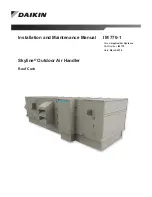
56
McQuay IM 487-4
Sequences of Operation
Heating
Gas Furnace, Modulating Burner (3 to 1 turn down)
Refer to “Standard Mod, furnace control (1000 MBH)” on
page 78 as you read this sequence of operation. Note that the
gas furnace wiring diagrams supplied with the units include a
detailed sequence of operation. Refer to the wiring diagram
supplied with the unit for exact wiring and sequence of
operation information.
When system switch S1 is closed, 115 VAC power is supplied
to the furnace control circuit. If burner switch S3 and safeties
HL22, HL23 are closed (line 603), terminal 5 (line 609) on the
flame safeguard control (FSG) energizes as does the
modulating gas valve VM1. If heating is enabled (MCB-BI4 is
energized—line 223) and heating is required, the MCB-BO11
energizes relay R20 (line 413). The normally open R20
contacts (line 603) close, and if manual burner switch S3 and
safeties HL22, HL23, FLC (high limit switch) (line 603), LP5,
and HP5 are closed (optional, not shown on page 78), terminal
6 (line 618) on the flame safeguard control (FSG) energizes.
FSG energizes terminal 4 to start the blower motor (BM) (line
609) through contactor M29 on large burners. If the blower is
operational, air switch AS (line 621) closes and makes
electrical continuity from FSG terminal 6 to 7. After a 90-
second prepurge period, FSG terminals 8 (line 613) and 10
(line 621) energize. As a result, ignition transformer IT and
pilot gas valve GV1 energize. The pilot flame ignites and is
detected by FSG through flame rod FD (line 612). Upon
detection of pilot flame after the 10-second trial for ignition
period, the FSG de-energizes terminal 10 and energizes
terminal 9 to energize main gas valves GV2 and GV3 (lines
617, 619) and low fire start relay R23 (line 624). The R23
contacts (lines 632 and 633) allow the MCB to modulate gas
valve actuator VM1 as required to satisfy the heating demand.
Whenever the burner is operating, its firing rate is determined
by the position of gas valve actuator VM1. This actuator
modulates the butterfly gas valve and combustion air damper,
thus varying the furnace firing rate between 33% and 100% of
full capacity. When the MCB-BO10 energizes (line 634), VM1
modulates toward open and the firing rate increases. When
MCB-BO9 energizes (line 633), VM1 modulates toward
closed and the firing rate decreases. When both MCB-BO10
and MCB-BO9 are open, VM1 holds its position and the firing
rate remains constant.
When heating is no longer necessary, MCB-BO11 opens,
de-energizing relay R20 and opening its contacts (line 603). As
a result, the flame safeguard control de-energizes, all gas
valves close, the combustion air blower motor stops, and gas
valve actuator VM1 closes. If the furnace is warm enough to
close it, the FLC fan controls switch (line 602) overrides
supply fan start/stop output MCB-BO1 through R25 (line 402)
and keeps the supply fan running until the furnace cools down
(this might happen during night setback operation).
If the furnace overheats, the FLC high limit control (line 603)
cycles the burner, preventing the furnace temperature from
exceeding the limit control’s setpoint. When the furnace cycles
off, low fire start relay R23 de-energizes. The normally closed
R23 contacts (line 633) cause VM1 to drive to its minimum
position, overriding MicroTech II control of VM1 via
MCB-BO10 and MCB-BO9. Because relay R23 de-energizes
whenever GV2 de-energizes, the burner always starts at low
fire.
Safety Lockout
If the pilot flame does not ignite or the flame safeguard fails to
detect its flame within 10 seconds, the flame safeguard control
enters the “safety lockout” state. FSG terminals 4, 8,9 and 10
de-energize and the burner shuts down. FSG terminal 3
energizes relay R24 (line 610). The R24 contacts (line 225)
signal the controller that the problem exists by energizing the
input to MCB-BI5. If a safety lockout occurs, manually reset
the flame safeguard control.
Artisan Technology Group - Quality Instrumentation ... Guaranteed | (888) 88-SOURCE | www.artisantg.com














































